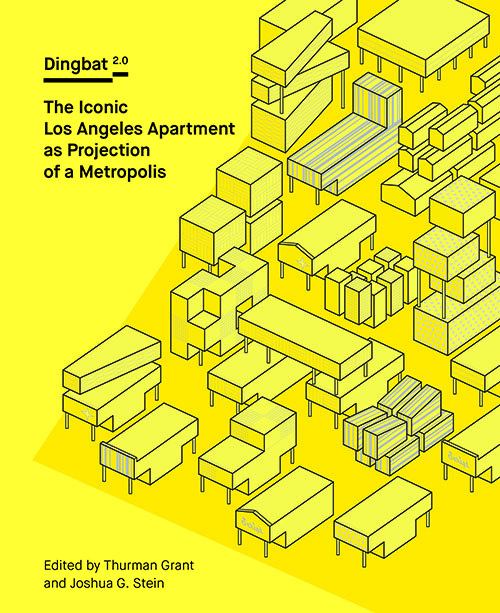Dingbat 2.0: The Iconic Los Angeles Apartment as Projection of a Metropolis
DoppelHouse Press and the Los Angeles Forum for Architecture and Urban Design recently announced the publication of the much-anticipated Dingbat 2.0: The Iconic Los Angeles Apartment as Projection of a Metropolis.
The publication is edited by Woodbury University faculty members Thurman Grant and Joshua G. Stein and includes contributions by Woodbury University faculty members Barbara Bestor and Alan Loomis.
Dingbat 2.0 is the first full-length critical study dedicated to the quirky and idiosyncratic “dingbat” apartment type, which for more than half a century has been largely anonymous, often misunderstood, and occasionally fetishized—as much for being ugly and ordinary as for being innovative, iconoclastic, and distinctly “L.A.”
The public is invited to the launch party for the book:
Saturday, April 30, 2016
Jai & Jai Gallery in Chinatown
648 North Spring Street, Los Angeles 90012
6pm to 9pm
The event will feature the editors plus speakers for a short discussion on dingbats, including Frances Anderton, host of the KCRW radio program DnA: Design and Architecture; architect Lorcan O’Herlihy, an innovator in multi-family housing in Los Angeles; and author and professor Dana Cuff of UCLA/cityLab whose essay “R1 and the Dingbat” is included in the Dingbat 2.0 publication.
What is a dingbat?
Built in the 1950s and ‘60s, the dingbat apartment was largely the result of planning codes put in place during the massive postwar expansion of Los Angeles. It is an identifiable, yet anonymous, vernacular building type, box-shaped and clad primarily in stucco, with apartments propped up on stilts over open carports. The dingbat’s unique decorative facades incorporate mid-century lighting elements with large typography spelling out names such as “The Capri” or “The Palms,” giving each building a pretense of distinction. As a housing type, the dingbat has enabled the dense sprawl for which Los Angeles is infamous while simultaneously creating a consistency of urban fabric achieved by few other 20th century cities.
“Many of today’s pressing issues are embodied in the dingbat.”
“Many of today’s pressing issues are embodied in the dingbat, either in its history or its current condition,” says editor Joshua G. Stein. “Los Angeles, and the metropolis in general, are faced with an increasing need to densify and provide housing for an influx of new urban dwellers.” Co-editor Thurman Grant continues, “A thorough examination of the dingbat demands that architects reckon with factors that we often leave off the table: the role of zoning, financing, development, and ownership.”
The L.A. Forum’s 2010 “Dingbat 2.0” international design competition drew innovative entries from professionals and students from 18 countries, re-envisioning the dingbat apartment, and by extension, the landscape of housing in Los Angeles for the 21st century. The Dingbat 2.0 publication includes documentation of the winning entries along with the panel discussions and debates that the Forum organized around the competition.
The book’s essay contributors include many familiar names from progressive architecture, urban planning history, and critical studies: Barbara Bestor, Aaron Betsky, James Black, John Chase, Dana Cuff, Thurman Grant, John Kaliski, John Southern, Joshua G. Stein, Steven A. Treffers, and Wim de Wit. Photographic series in the book are by Judy Fiskin, Paul Redmond and Lesley Marlene Siegel. A new typology of dingbats by Thurman Grant and James Black is an exhaustive study of the housing type and will be invaluable to educators, students of architecture and planners alike.
The dingbat may play a role in the shaping of the future city
The book Dingbat 2.0: The Iconic Los Angeles Apartment as Projection of a Metropolis is being praised for forwarding ideas about how the dingbat may play a role in the shaping of the future city. “Dingbat 2.0 gives an often-maligned housing type its long overdue moment in the sun,” says Los Angeles Principal City Planner Ken Bernstein, “reimagining the potential of the dingbat for the twenty-first century—at a moment when the imperative to create livable and modest affordable housing is more pressing than ever.”
“This book is extremely valuable for designers, particularly when one considers that architects generate species of buildings,” says Jimenez Lai, founder of the acclaimed studio Bureau Spectacular. “An in-depth study of this particularly indigenous species to Los Angeles allows architects to not only become familiar with the causes and effects of the dingbat, but also the many possibilities for its future morphologies.”
